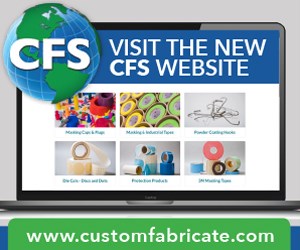Technical Coatings for Additive Manufacturing Show Promising Results
Technical Coatings enable smooth and sealed surfaces with specific functions.
Additive manufacturing (AM) has many advantages: custom manufacturing, flexible production and easy customization, for example. Yet many products have a high surface roughness and porosity. The post processing of the fabricated parts is time consuming and often a significant cost factor for manufacturers. Technical coatings open up new possibilities for the AM market, especially in industrial production.
In a joint project, researchers from the Belgian NPO Sirris and the Fraunhofer Institute for Applied Polymer Research IAP have investigated technical coatings for additive manufacturing (TCAM) with promising results.
AM describes the construction of an object layer by layer using a 3D-model. The technologies vary but 3D printing is probably the best known. However, selective laser sintering (SLS), stereolithography (SLA) or material jetting (MJ) play important roles in the AM market. While the first AM technologies were developed for rapid prototyping, today, AM is taking the leap into industrial production. It is one of the important future technologies that will influence the manufacturing market and beyond. The industry can profit from AM with its production on-demand capabilities, its and flexible adaptability and the possibility to produce small quantities. However, the surface of the fabricated components is usually very rough and porous.
To meet this challenge, two partners investigated technical coatings for additive manufacturing in a joint project: Sirris is an organization focused on finding solutions for technological challenges, usually in projects with universities, research centers, companies, associations and other institutions. Researchers at the Fraunhofer IAP, among other areas of expertise, have long years of experience in technical coatings.
“Today, with the transition from rapid prototyping to industrial production, the demands on AM-manufactured components are growing. Being able to warrant consistent material quality is essential for industry producers. In addition, demands on the surface quality are growing,” says Dr. Andreas Holländer, expert in surface technology at the Fraunhofer IAP.
With technical coatings, the Sirris and Fraunhofer researchers were able to significantly improve AM-produced parts regarding surface roughness and porosity. It turned out that the combination of lacquering and polishing is the most efficient technique for surface optimization in AM. In addition, components can be functionalized further by using special lacquers or surface treatments. In the current project, the scientists metallized the smoothed components. The metal coating is a visible example for the functionalization process. Improved scratch resistance, antimicrobial properties and many more features are applicable.
Sirris provided different components made with SLS, SLA, MJ, and FDM (fused deposition modeling = 3D printing). All methods pose different challenges to surface treatment.
“With years of expertise in surface treatment, we are able to meet a wide range of requirements. We analyzed each part in the first step to determine the specific properties. Afterwards we were able to activate, paint, and polish and, in this case, metallize the respective surface with the appropriate method,” says Holländer, who leads the research group at the Fraunhofer IAP.
Patrick Cosemans from Sirris Flanders adds: “If we only polish our finished components, it takes a long time, and especially with fine, detailed features, we change their shape. It comes to abrasion, which we want to avoid. With the Fraunhofer IAP we have developed possibilities to overcome the current problems, especially the porous and rough surface, in additive manufacturing.”
Conventional production methods often reach their limits with complex components. The more complex a component, the more difficult and expensive it becomes in conventional production. AM opens up possibilities to produce complex components faster and more cost-efficiently. With AM, a component that would conventionally consist of many individual parts and would have to be assembled can be created in one step.
“It is important,” says Dr. Holländer, “that every part of the component’s surface has the required quality. In complicated parts, some surfaces are difficult to reach. With the appropriate surface treatment technology, which in future will even be integrated into the AM machines, we are able to functionalize even complex components completely."
Finishing the project both partners conclude that AM in combination with established technologies provides even better capabilities and more possible applications than AM alone.
Related Content
NASF/AESF Foundation Research Project #123: Electrochemical Manufacturing for Energy Applications - 6th Quarter Report
The NASF-AESF Foundation Research Board selected a project on electrodeposition toward developing low-cost and scalable manufacturing processes for hydrogen fuel cells and electrolysis cells for clean transportation and distributed power applications. In this period, work focused on 3D printing anode support for solid oxide fuel cells, SOFC (or cathode for solid oxide electrolyzers, SOEC) based on our designed optimization outlined in the previous report.
Read MoreNASF/AESF Foundation Research Project #123: Electrochemical Manufacturing for Energy Applications - 1st Quarterly Report
For 2022, NASF-AESF Foundation Research Board has selected a project on electrodeposition toward developing low-cost and scalable manufacturing processes for hydrogen fuel cells and electrolysis cells for clean transportation and distributed power applications. This report introduces the project and outlines the work to be undertaken.
Read MorePlating Additively Manufactured Plastic Parts
Using electroplating to enhance the structural properties of 3D printed parts.
Read MoreNASF/AESF Foundation Research Project #123: Electrochemical Manufacturing for Energy Applications – 2nd Quarterly Report
For 2022, NASF-AESF Foundation Research Board has selected a project on electrodeposition toward developing low-cost and scalable manufacturing processes for hydrogen fuel cells and electrolysis cells for clean transportation and distributed power applications. This report is the 2nd quarterly report, covering work during April-June 2022 and consists of an edited manuscript, “Manufacturing and Thermal Shock Characterization of Porous Yttria-Stabilized Zirconia for Hydrogen Energy Systems.”
Read MoreRead Next
Episode 42: An Interview with Robin Deal, Hubbard-Hall
Hubbard-Hall wastewater treatment specialist Robin Deal discusses the latest trends in wastewater management.
Read MoreThe 2024 Ford Mustang: All the Colors Available
Although Chevrolet has announced the end of the Camaro and Dodge is offering “Last Call” editions of the Charger and Challenger, the Ford Mustang is launching to its seventh generation.
Read MorePowder Coating 4.0: Smarter, Faster, More Efficient and Connected
New tools reduce cost and waste, lower manufacturing footprint of powder coating operations.
Read More

























